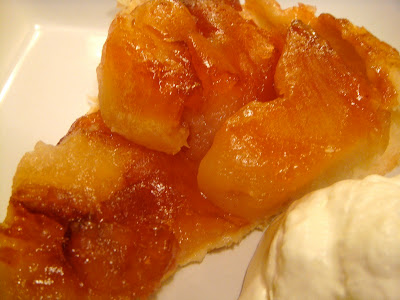This recipe takes patience. Seriously. First, there's waiting for the dough to chill, then there's waiting for the sugar to caramelize, then there's waiting for the crust to bake, and finally waiting for the whole thing to cool and set. And during those last three steps, you have that overwhelming smell of baked apples and caramelized sugar taunting you. But fortunately, the tarte Tatin is worth the wait.
The finished product is a carousel of caramel-soaked, tender apples set on a light, buttery crust. The flavor is so unexpected, at least for me it was. Most apple dishes I've had are flavored with cinnamon, but the tarte Tatin is simply apples, sweetened and cloaked with a reduction of the apples' juices and perfectly caramelized sugar.
While there are many tarte Tatin recipes out there to choose from, I turned to Bouchon
The recipe warned that getting the caramel right would be the hardest part. Luckily, at this point I'm pretty confident with my caramel skills. I've come a long way from making caramel-filled cupcakes that turned out to have rock hard, inedible centers. My best advice to you is not to stray far once the sugar starts bubbling. Caramel turns very quickly once it starts to turn.
Quick note: As I was typing up the recipe, I realized I made a very silly mistake. The recipe calls for 8 ounces of butter, and I used 1 stick, thinking 8 tablespoons of butter. I really should have used 2 sticks! Somehow my pate brisee still came out okay, but below I've given you the right amount of butter to use.
Ingredients
Pate Brisee
2 cups all-purpose flour, sifted
1 teaspoon kosher salt
2 sticks butter, cut in 1/4-inch cubes
1/4 cup ice water
Apples
10 apples
3/4 cup sugar
2 tablespoons unsalted butter
Preparation
Make the pate brisee: Combine 1 cup flour and salt in bowl of electric mixer fitted with paddle. With the mixer on low, add the butter a few cubes at a time. Increase speed to medium, and mix until butter is completely combined with flour.
Reduce speed to low, and add remaining cup of flour. Mix to combine, and then add the water. Mix until dough starts to come up around paddle and feels smooth, not sticky.
Divide the dough in half. Pat each piece into a disc and wrap them in plastic wrap. Double-wrap one disc and freeze it for use in another recipe. Refrigerate the other disc for 1 hour.
Choose a pan to make the tarte Tatin in. The pan should be round, at least 9 1/2 inches wide, and 1 3/4 inches deep. I used a Le Creuset cast iron skillet.
Remove the pate brisee from the fridge, and roll it out into a circle slightly larger than the pan. Fold the dough in half and in half again, put it on a plate, cover it with plastic wrap, and return it to the refrigerator.
Peel and core the apples, and slice off the tops and bottoms, so they are flat. Then cut the apples in half lengthwise.
Spread the sugar in an even layer in the pan. Cut the butter into 6 pieces and scatter them on top of the sugar.
Arrange the apples, standing up around the perimeter of the pan with all the halves facing the same direction. They should fit together snugly. Stand more apples pieces up in the center. Save any remaining pieces to add in once the apples start cooking and shrinking.
Place the pan over medium heat to melt the sugar. It will start bubbling. Rotate the apples all together occasionally to keep them from sticking to the pan. I just used my hands to turn the entire circle of them, but the recipe suggests using the lid of a pan once the sugar starts bubbling so you don't burn your hands.
Watch for the sugar to start caramelizing. You're looking for a deep amber color.
Meanwhile, preheat the oven to 375 degrees.
As soon as the sugar gets to the deep amber color, remove the pan from the stove. (Because it's hard to tell what color the sugar is against the pan, I dribbled it on a white plate to check the color.)
Remove the dough from the refrigerator, and drape it over the apples. Tuck the edges in around the apples (and trim the dough if necessary).
Bake for 40 minutes or until dough is golden brown.
Remove the tart from the oven, and let it sit for 20 to 30 minutes.
Carefully loosen the edges of the tart, then set an inverted plate over the tart, and flip the pan over so the tart ends up on the plate. Do this carefully as some of the apples may stick. Rearrange any apples if necessary.
The recipes suggests that the tart is best at room temperature or after being refrigerated, but I couldn't wait that long, so I tried it warm and thought it was just heavenly with a dollop of homemade whipped cream.
What are your plans for the long weekend? I'm off to the Cape tomorrow night!














